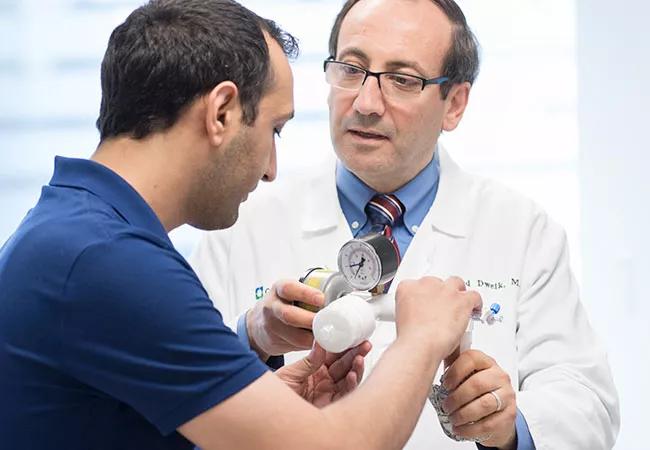Study shows five VOCs correlate well

A simple, noninvasive test for kidney disease may be closer than we think, thanks to the work of researchers in the Glickman Urological & Kidney Institute and Respiratory Institute at Cleveland Clinic.
Advertisement
Cleveland Clinic is a non-profit academic medical center. Advertising on our site helps support our mission. We do not endorse non-Cleveland Clinic products or services. Policy
A team of physicians and researchers, led by critical care nephrologist Sevag Demirjian, MD; pulmonologist Raed Dweik, MD; and internal medicine resident Kelly Paschke, DO, has identified five chemical compounds present in the breath that have a high correlation with identification of end-stage renal disease.
“We have shown a proof of concept that it is possible to detect kidney disease through a breath test and without the need for a blood draw or laboratory analysis,” Dr. Demirjian reports. “These are very promising early results, and we hope to develop this into a practical tool in the coming years.”
Their study, Molecular Breath Analysis Identifies the Breathprint of Renal Failure, published in the Journal of Breath Research, compared volatile organic compounds (VOCs) present in the breath of 86 patients known to have renal failure with the breath of 25 healthy controls using selected-ion flow-tube mass spectrometry (SIFT-MS).
Results of the full analysis show three known VOCs (2-propanol, ammonia and acetaldehyde) and two unnamed compounds (O2+ 50 and NO+ 76) are highly significant for identifying renal failure based on breath analysis.
Recent technological advances in VOC detection and spectral analysis have expanded into the hundreds the number of individual compounds detectable in the breath, Dr. Dweik explains. Furthermore, enhanced device sensitivity allows these compounds to be sniffed out and quantified in the range of parts-per-trillion. Dr. Dweik has been researching breath analysis for more than two decades.
Advertisement

“It’s similar to going from standard to high-definition television,” says Dr. Demirjian of recent improvements to the device. “The number of compounds we’re able to detect and the level of detail we’re able to see makes studies like this possible for the first time.”
Dr. Paschke believes that identification and validation of these compounds could lead to a rapid-response breath test to determine whether patients have kidney disease.
“This type of testing could have clinical implications for numerous patients, particularly because renal disease is often asymptomatic for many months,” says Dr. Paschke. “Applications of this research are far-reaching and could improve care in locations as varied as Cleveland Clinic and community clinics in developing countries.”
Among the practical limitations of the technology is the sheer size of the testing device, says Dr. Demirjian. However, Drs. Demirjian, Dweik and Paschke are hopeful that technical hurdles can be overcome and devices miniaturized—especially now that evidence exists for a meaningful clinical impact.
Advertisement
Advertisement

Looking at the real-world impact and the future pipeline of targeted therapies

The progressive training program aims to help clinicians improve patient care

New breakthroughs are shaping the future of COPD management and offering hope for challenging cases

Exploring the impact of chronic cough from daily life to innovative medical solutions

How Cleveland Clinic transformed a single ultrasound machine into a cutting-edge, hospital-wide POCUS program

Collaborative patient care, advanced imaging techniques support safer immunotherapy management

Potential options for patients who do not qualify for modulator therapies

Rising rates in young miners illustrate the need for consistent prevention messaging from employers and clinicians